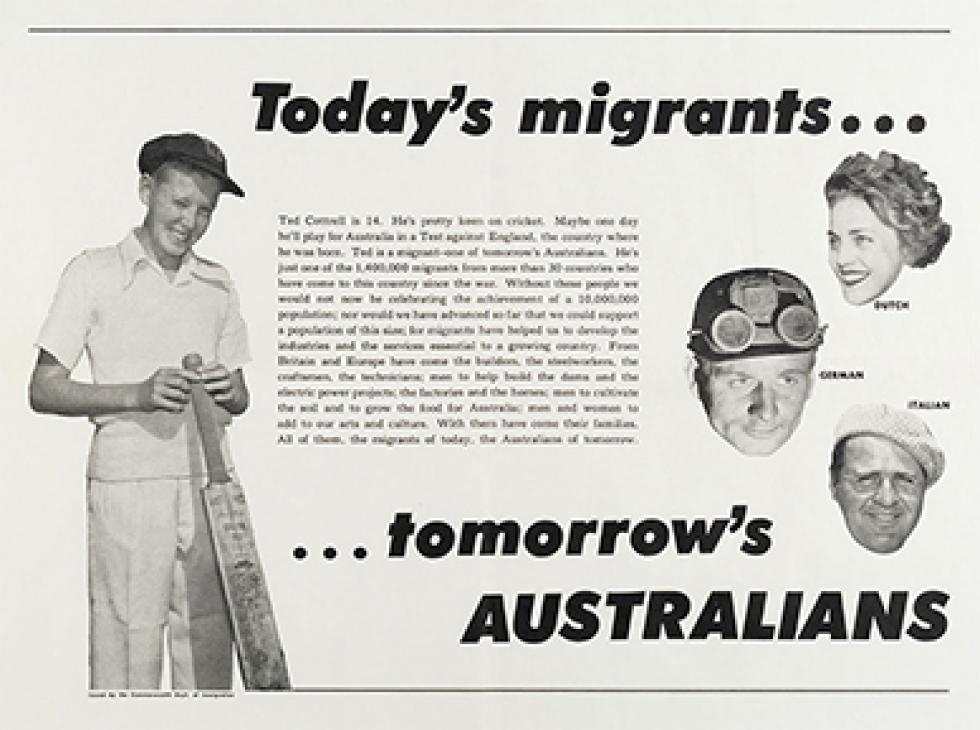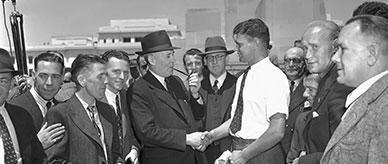


Transcript
Today's migrants......tomorrow's Australians
Ted Cottrell is 14. He's pretty keen on cricket. Maybe one day he'll play for Australia in a Test against England, the country where he was born. Ted is a migrant – one of tomorrow's Australians. He's just one of the 1,400,000 migrants from more than 30 countries who have come to this country since the war. Without these people we would not now be celebrating the achievement of a 10,000,000 population; nor would we have advanced so far that we could support a population of this size; for migrants have helped us to develop the industries and the services essential to a growing country. From Britain and Europe have come the builders, the steelworkers, the craftsmen, the technicians; men to help build the dams and the electric power projects; the factories and the homes; men to cultivate the soil and to grow the food for Australia; men and women to add to our arts and culture. With them have come their families.
All of them, the migrants of today, the Australians of tomorrow.
About this record
This poster, titled Today's migrants…tomorrow's Australians, shows a young man posing with a cricket bat, as well as three people identified as Dutch, German and Italian. The poster provides information about the advantages of accepting migrants to Australia. It was issued by the Department of Immigration, as sighted in the bottom left-hand corner.
Educational value
- The Department of Immigration was established in 1945, at the end of World War II. The main aim of the department was to increase Australia's population for defence and economic reasons. As seen in the poster, British people were considered the most desirable candidates for immigration, but the government soon realised that it would be necessary to source 'suitable' migrants from other European countries. The department established migrant-processing centres overseas, and chose migrants based on their skills and prospects of assimilating in Australia.
- In 1947, a total of 97 percent of people in Australia were either born here or in Britain. This was partly a result of the Immigration Restriction Act 1901 and the White Australia policy. Many Australians feared that new migrants would take their jobs and jeopardise the British-based Australian way of life. The Department of Immigration set out to allay such concerns by promoting the merits of migrants. It described them as 'New Australians' or 'Tomorrow's Australians', which suggested that they would readily take on Australia's culture and identity. The department also highlighted the importance of new migrants taking on employment in what Australians considered 'dirty jobs'.
- The Department of Immigration had expected that migrants would assimilate within one or two generations. It considered that, through immersion in the community, migrants would learn English and abandon their own language and culture. Many migrants had difficulties speaking English, which precluded them from building relationships with other Australians. They experienced racism, such as name-calling, and witnessed the preferential treatment of British-born Australians. This often saw migrants move into neighbourhoods where people shared their language and culture, and establish clubs based on their country of origin.
- This poster was one of many promotional campaigns created to convince the public that immigration was good for Australia. Post-war migrants laid the foundation for the nation's continued economic growth. Migrants provided both the workers and the market for products, which saw the output of Australia's factories exceed that of its primary industry for the first time. Projects such as the Snowy Mountains Hydro-electric Scheme depended on migrant labour. This project saw 70,000 migrants construct 16 major dams, 145 kilometres of tunnels and pipelines, and seven power stations.
Need help with your research?
Learn how to interpret primary sources, use our collection and more.

